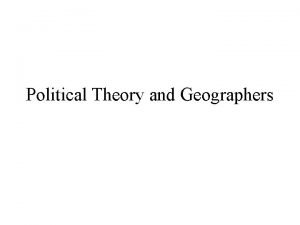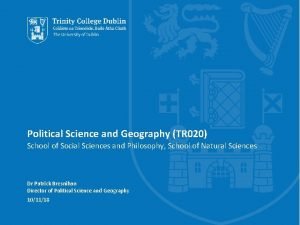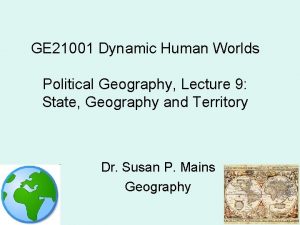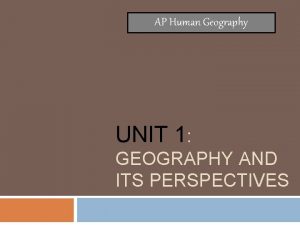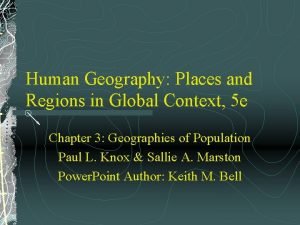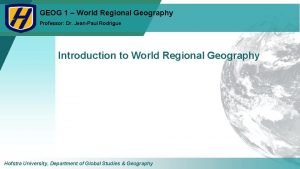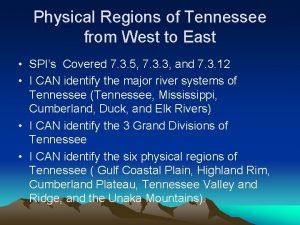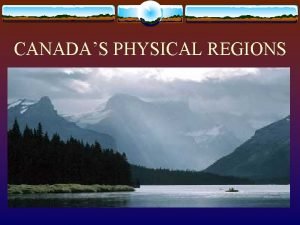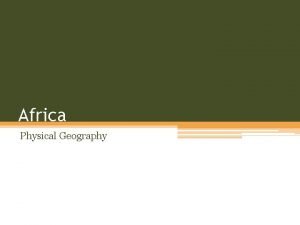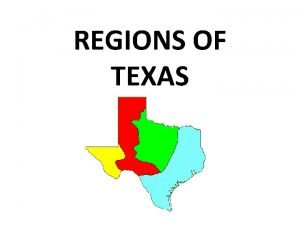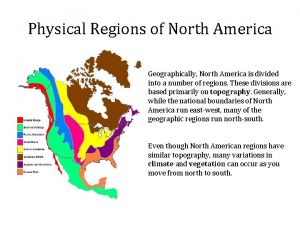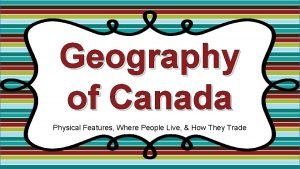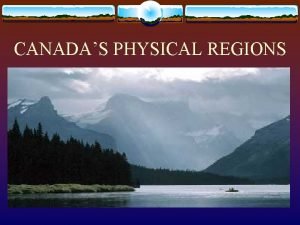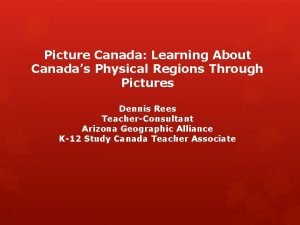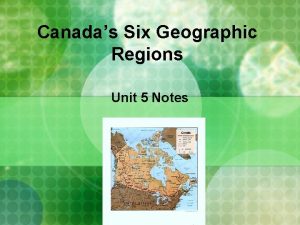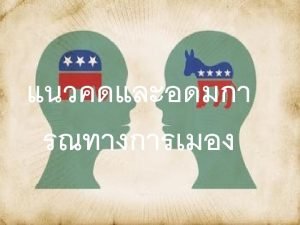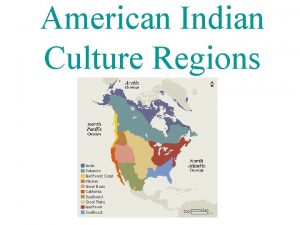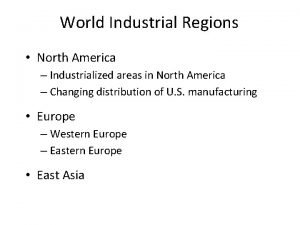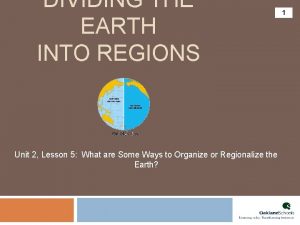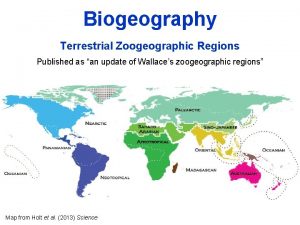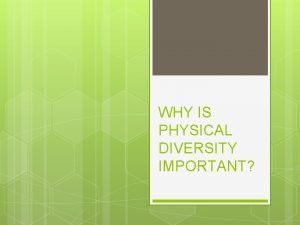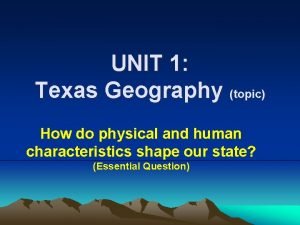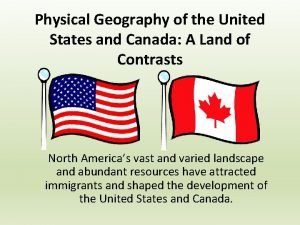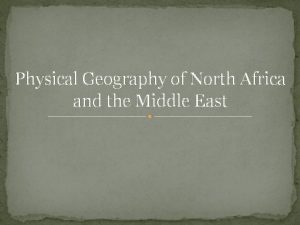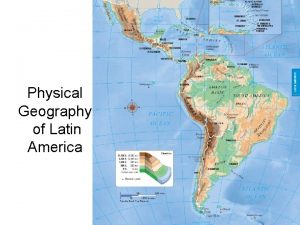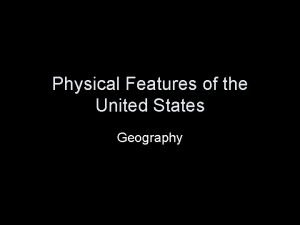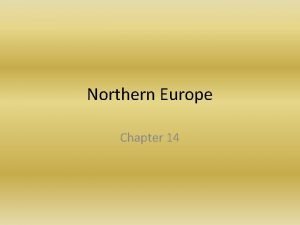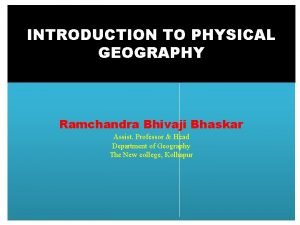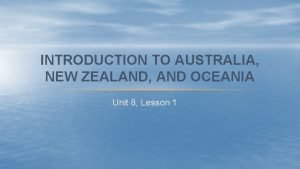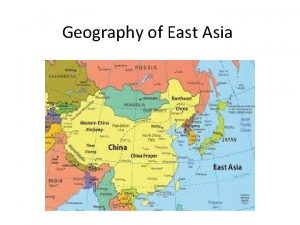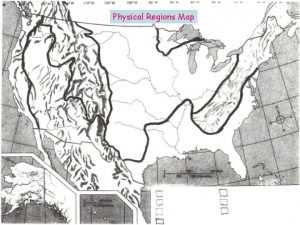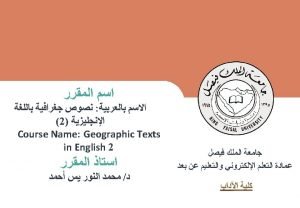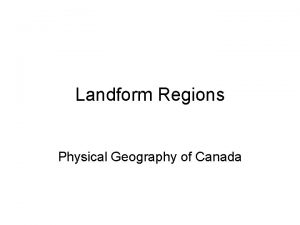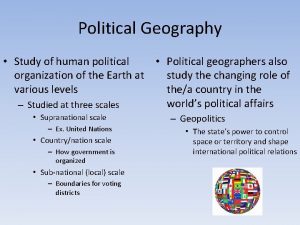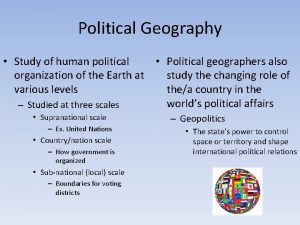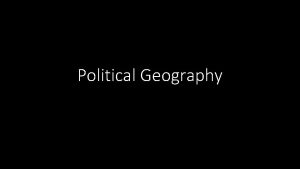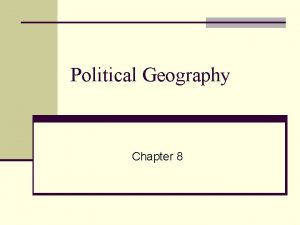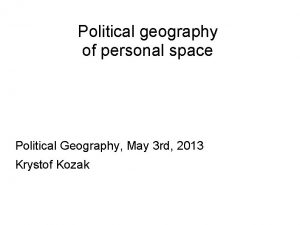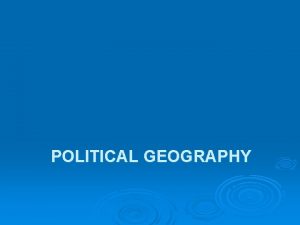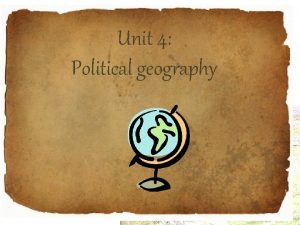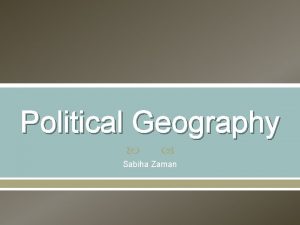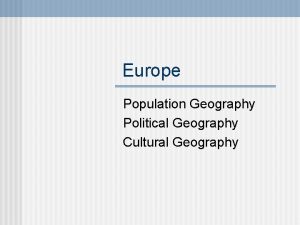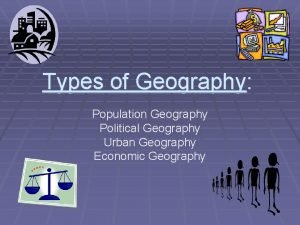Geography I World Regions A Political Regions Physical












































- Slides: 44

Geography I. World Regions

A) Political Regions �Physical Regions include- climate, vegetation, political, economic, and cultural regions.

B) Landforms and Physical Regions �Archipelago- A group of islands scattered in an expanse of water. �Bay- A body of water partly enclosed by land, with access to the ocean. �Canyon- A deep and narrow valley with steep sides and a stream of water flowing through it. �Fjord- A narrow, deep inlet of the sea between high, rocky cliffs created by glaciers. �Channel- A natural or artificial course for running water.

Landforms and Physical Regions �Delta- The landform at the mouth of a river created by deposits of sediment. �Gulf- part of the ocean that juts into the land. �Island- A body of land smaller than a continent, that is entirely surrounded by water. �Isthmus- A narrow strip of land with water on both sides that connects two larger bodies of land. �Lake- A body of water surrounded entirely by land �Mountain Range- A chain of connected mountains �Peninsula- A piece of land jutting into the water and almost surrounded by it. �Plain- A broad area of mostly flat land at a low elevation.

Landforms and Physical Regions �Desert- A dry, barren land. �Volcano- An opening in earth's crust through which lava, steam and rock fragments may erupt. �Mesa- A large, flat - topped hill common in the southwest U. S. . �Glacier- A large mass of ice that moves slowly, from higher to lower ground. �Rainforest- Dense forest that receives great amounts of rain.

Landforms and Physical Regions �Plateau- A broad area of mostly flat land at a high elevation. �River- A large stream of water that flows through the land into the lake, a sea, or an ocean. �Sea- A large body of salt water, smaller than an ocean. �Strait- A stretch of water joining two large bodies of water, narrower than a channel. �Tributary- A stream or river that flows into a large stream or river. �Valley- An area of low - lying land between mountains of hills.

C) Vegetation Regions � Tropical Rainforest- near equator, Brazil (amazon), Mid Africa, Indonesian Archipelago � Savanna- directly above/below equator, Africa (think Lion King), some of Australia, India, Eastern South America � Tundra- the North Pole, top of Russia and Canada, Greenland � Boreal Forest (Taiga)- most of Canada and Russia � Mediterranean Shrub land- areas around the MEDITERRANEAN Sea, also part of California and the bottom of South Africa � Mid-latitude Forest- Eastern US, Western Europe, Eastern China � Hot Desert- Western US, top of Africa, some of Australia, Saudi Arabia and some of the Middle East

D) Climate Regions � Tropical Dry � 1. Hot temperatures year-round. � 2. A wet season and a dry season. � Marine West Coast � 1. Cool Summers � 2. Mild Winters � 3. Rain throughout the year � Tropical Wet � 1. Hot temperatures year-round � 2. Rains quite a bit throughout the year. � Subarctic � 1. Cool Summers � 2. Very Cold Winters � Tundra � Humid Subtropical � 1. Cool summers � 1. Hot and humid summers. � 2. Extremely cold winters � 2. Mild winters � 3. Rains throughout the year, but heaviest in the summer months. � Ice Cap- Below freezing throughout the year. � Mediterranean � 1. Hot and dry (little rain) summers � 2. Mild and wet (more rain) winters � Humid Continental � 1. Hot and humid summers � 2. Cold and snowy winters. � 3. Good amount of rain in summer � Arid- Extremely dry (less than 10 inches of rain per year) � Semi-Arid- Pretty dry (10 - 20 inches of rain per year) � High Elevation � 1. Found in areas with mountains. � 2. Cooler temperatures throughout the year. � 3. Temperatures get colder as the elevation gets higher.

Climate Regions �Wind and ocean current are the two things most responsible for our weather and the patterns it creates

E) 5 Themes Of Geography �MR. LIP �Movement- The travel of people, goods, and ideas from one location to another. �Region- area described by its features �Location- Where something is �Interaction- How humans interact with their environment �Place- specific point on earth

Geography II. Africa & the Middle East

A) Physical Geography �Africa is the 2 nd largest after Asia. �Mainly dry desert areas �Birthplace of the three religions of Judaism, Christianity and Islam. �Africa & the Middle East have the largest Oil deposits in the world. �Sub-Saharan Africa is the least developed area in the world. �Early Civilizations developed here because of the underground water & the rivers (Nile, Euphrates & Tigris)

Physical Geography �Long coastline �Rivers �Waterways constantly need upkeep to allow ships to pass through. (think Silt) �Deserts �Oil deposits

B) Ecosystems of Africa & ME �Two different areas where plants and animals inhabit. �Savanna & rainforest �Savanna- wet & dry lions, giraffes, and elephants (large animals) �Rainforest- snakes, monkeys ect. , tigers

C) Economy �Cocoa �Coffee �Cotton �Peanuts �Palm oil �OTHER NOTES � Apartheid- a policy or system of segregation or discrimination on grounds of race. �Nelson Mandela ended apartheid.

Geography III. Asia

Asia

Asia �Is the largest continent on earth �Most people in the world live here �Many island chains on this continent- archipelagos �Russia is the largest, then China

A) Physical Geography of Asia �Rivers provide most of the areas that are not covered in mountains with fertile soil. �Himalayan mountains in this region are the highest in the world. �Climate in this region ranges from monsoon rains to winter weather. �Depends on the location Russia v Japan �Longitude and latitude dictate

B) Vegetation, Agriculture & Economy �Forest and grassland replaced by farmland �Rainforests being cut down �Tea, cotton, iron, limestone, rice, sugarcane, rubber, iron-ore, coal (China is mainly responsible for these goods)

C)Human & Political Geography �Other religions in the Asian continents are Hinduism, Buddhism, Islam, Jainism, Christianity, and Sikhism. �Countries like India, Sir Lanka, and Pakistan. �Religion and philosophy helped to create hierarchical society �This was removed by a revolutionary movement, civil war and war with Japan. �Communists ruled with Mao Zedong and the Samurai warriors.

C)Human & Political Geography �India's Economy is private enterprise with state control �China’s Econ is state is dominant, Mao, nationalized all industry and turned farming into a team effort �His successor Deng Xiaoping introduced foreign investment and gave some private ownership. �US unpopular due to Vietnam war and support for Pakistan in the war against India �US wants to use trade as a lever to force China to respect human rights.

Geography IV. Europe

Europe

Europe �Asia is on the same continent as Europe. �Europe was split into east and west known as the Iron Curtain. �Fell at the end of the cold war. �Western Europe and Soviet backed Eastern Europe.

A)The Impact of Geography on Agricultural & Industry �No spot in Europe is less than 300 miles from the coast. �The sea is used for fishing and extracting oil �The sea is the reason for the temperate climate in Europe. �The Great European Plain covers area from Germany to Russia. �Eastern Europe is cold. Very Cold. �Very Mountainous.

B) Cultural & Human Geography � 26 Independent nations in Europe �Site of World War I &II � 2 nd Largest exporter of agricultural goods. �The decline of communism to more democratic governments has caused a break up in Europe �They have joined the EEC & NATO �Closely allied w/ the USA

Geography V. Latin America

Latin America �Most of South America, Mexico and central America � 4 th Largest continent

A) Landforms �Andes Mountains stretch 4, 000 miles here. �Mexico 15% of land is used for farming due to the rugged landscape. �The Amazon River Basin Is located in LA

B) Climate �Most of LA lies in the tropics- 80 Degrees �Sometimes Hurricanes threaten this region �Products that thrive in this climate are cocoa, sugar cane, tobacco, coffee

C) Economic Geography �With the small amount of land that can support farming land is being cleared in the amazon. �Deforestation contributes to Global Warming when carbon dioxide is released when trees ae cut down �Many minerals found in this region copper, oil, tin.

D) Human Geography �Latin America is divide by class rich v poor �Relations with the US are stormy �Since the Monroe Doctrine- document that opposed European colonization �Although the US and certain people view this as US investment many see it as US Imperialism

Geography VI. Canada

Canada � 26 million people live in Canada � 80% live on the border between the US & Canada

A) Physical Geography �Similar to areas of the US �Large prairies, mountains, the great lakes �Weather much like Michigan

B) Natural Vegetation, Resources and Economy �Maritime- Island states or provinces �Canadas resources are things like fish, forestry, wheat, dairy, oil and hydroelectric power. �Hydroelectric – power or electricity made from the movement of water

C)People and Culture �Canada is influenced by the colonization of the French and the British. �Its capital Toronto, is the largest city. �The British Monarchy is still their head of state

D) Relationship with the USA �Canada is completely free of Britain and France but their ties with Britain remain strong �The relations with the US are more important �The USA trade with Canada more than any other country 20% � 70% of all Canadian exports go to the USA �The USA and Canada have had issues as well but resolve them peacefully.

Geography VII. Global Issues

Global Issues �Some of the issues the world faces are nuclear war, pollution, global warming, population rising, continua ting warfare.

A) Environmental pollution �Global warming- the increase in earth temperature �Causes sea levels to rise, melting of the glaciers and ice caps �More extreme weather �Emissions- releasing carbon dioxide into the atmosphere �Deforestationcutting/burning of trees �Desertification- area turning desert

B) Nuclear Proliferation �Proliferation- rapid increase �The increase in nuclear energy and weapons poses a threat of war �If nuclear were to occur the earth and all who live here will be threatened.

C)Ethnic, Tribal, and religious war �Treaty of Versailles (1919)- created after WWI made new nations from ones that were defeated. �After WWII many of these new nations become product of Soviet-Russia. �After the cold war (not a real war)- the Russian empire fell apart creating even more new nations and more battles. �Ethnic Cleansing – killing or removing people of a different ethnicity
 Frq ap human geography format
Frq ap human geography format Stateless nation
Stateless nation Physical regions of the world
Physical regions of the world Genetic classification of boundaries
Genetic classification of boundaries Objectives of political geography
Objectives of political geography Political geography of australia
Political geography of australia Relationship between political science and geography
Relationship between political science and geography 1990 european map
1990 european map Political geography
Political geography Political geography
Political geography Political geography
Political geography Difference between centrifugal and centripetal force
Difference between centrifugal and centripetal force Formal region example
Formal region example Human geography places and regions in global context
Human geography places and regions in global context Geography: realms, regions, and concepts (doc or html) file
Geography: realms, regions, and concepts (doc or html) file Political and physical features of latin america
Political and physical features of latin america What is the relative location of australia
What is the relative location of australia 5 themes of geography ap human geography
5 themes of geography ap human geography Regions of tennessee
Regions of tennessee Canada physical regions
Canada physical regions 8 major physical regions of africa
8 major physical regions of africa What are the 4 regions of texas
What are the 4 regions of texas Physical regions of north america
Physical regions of north america Physical features of canada
Physical features of canada Physical regions of canada
Physical regions of canada Canadas physical regions
Canadas physical regions Canadas 5 regions
Canadas 5 regions World political parties
World political parties Cultural regions of the world map
Cultural regions of the world map World major industrial regions
World major industrial regions Geoearth game
Geoearth game How to divide the world into regions
How to divide the world into regions An update of wallace’s zoogeographic regions of the world
An update of wallace’s zoogeographic regions of the world Phytogeographical regions
Phytogeographical regions Why is physical diversity important
Why is physical diversity important Physical geography of texas
Physical geography of texas Physical geography of us
Physical geography of us North africa physical geography
North africa physical geography Middle america
Middle america United states physical geography
United states physical geography Scandinavia physical features
Scandinavia physical features Physical geography of south america webquest
Physical geography of south america webquest Physical geography definition
Physical geography definition Lesson 1 physical geography of australia and new zealand
Lesson 1 physical geography of australia and new zealand Geography of asia
Geography of asia



